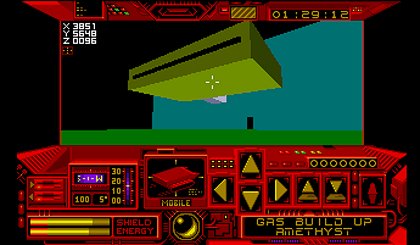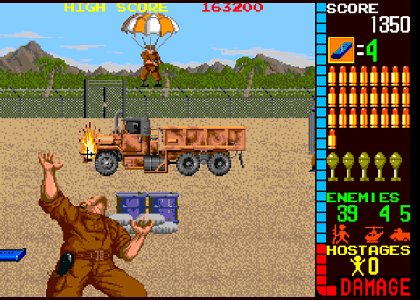
Incentive's Driller boasted filled polygon 3D and 360 degree movement.
Even when 16-bit arcade tech arrived in the middle of the 80s, first person gaming wasn’t an area many developers dared to explore. For the most part, gamers were restricted to more ambitious and graphically enhanced versions of the kind of shooting gallery games which had been popular in arcades for decades.
Usually played out in first person, and played with a light gun, the action moved the players on-rails, and gradually became more ambitious in scope up to the point where they were effectively pre-scripted versions of the first person shooters we would grow to love in the 1990s.

Operation Wolf was a popular choice among coin-op groupies.
Japanese arcade starlet Taito was one developer that pushed the boundaries of on-rails first person shooting titles, and hit paydirt with the worldwide success of its 1987 Rambo-inspired arcade title Operation Wolf, quickly followed by Operation Thunderbolt. It took the idea even further with the often-overlooked Space Gun (1990). Complete with a foot pedal control, players could back off from enemies as they wandered the corridors of an over-run space ship.
As developers began to get grips with some of the increasingly popular 16 bit systems, experiments were made with free-roaming 3D engines that amounted to more than just an interesting tech demo. id Software’s first stab, 1991′s Hovertank 3D, was a huge stepping stone for the genre in that the game actually ran as smoothly as an action game.





 Satoru Iwata Video Interview - the late Nintendo president spoke with Kikizo in 2004 as 'Nintendo Revolution' loomed.
Satoru Iwata Video Interview - the late Nintendo president spoke with Kikizo in 2004 as 'Nintendo Revolution' loomed. Kaz Hirai Video Interview - the first of Kikizo's interviews with the man who went on to become global head of Sony.
Kaz Hirai Video Interview - the first of Kikizo's interviews with the man who went on to become global head of Sony. Ed Fries Video Interview - one of Xbox's founders discusses an epic journey from Excel to Xbox.
Ed Fries Video Interview - one of Xbox's founders discusses an epic journey from Excel to Xbox. Yu Suzuki, the Kikizo Interview - we spend time with one of gaming's most revered creators.
Yu Suzuki, the Kikizo Interview - we spend time with one of gaming's most revered creators. Tetris - The Making of an Icon: Alexey Pajitnov and Henk Rogers reveal the fascinating story behind Tetris
Tetris - The Making of an Icon: Alexey Pajitnov and Henk Rogers reveal the fascinating story behind Tetris Rare founders, Chris and Tim Stamper - their only interview? Genuinely 'rare' sit down with founders of the legendary studio.
Rare founders, Chris and Tim Stamper - their only interview? Genuinely 'rare' sit down with founders of the legendary studio. The History of First-Person Shooters - a retrospective, from Maze War to Modern Warfare
The History of First-Person Shooters - a retrospective, from Maze War to Modern Warfare
[...] Parte 1 (1974-1995) [...]